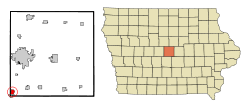Slater, Iowa
Slater is a city in Story County, Iowa, United States. The population was 1,489 at the 2010 census.
Slater, Iowa | |
|---|---|
 Flag | |
 Location of Slater, Iowa | |
| Coordinates: 41°52′49″N 93°40′54″W | |
| Country | |
| State | |
| County | Story |
| Area | |
| • Total | 1.92 sq mi (4.96 km2) |
| • Land | 1.92 sq mi (4.96 km2) |
| • Water | 0.00 sq mi (0.00 km2) |
| Elevation | 1,037 ft (316 m) |
| Population | |
| • Total | 1,489 |
| • Estimate (2019)[3] | 1,458 |
| • Density | 761.36/sq mi (293.96/km2) |
| Time zone | UTC-6 (Central (CST)) |
| • Summer (DST) | UTC-5 (CDT) |
| ZIP code | 50244 |
| Area code(s) | 515 |
| FIPS code | 19-73515 |
| GNIS feature ID | 0461667 |
History
There has been a post office in Slater since 1887.[4] The city was named for Michael Slater, the original owner of the town site.[5]
Geography
Slater is located at 41°52′49″N 93°40′54″W (41.880265, -93.681642).[6]
According to the United States Census Bureau, the city has a total area of 1.26 square miles (3.26 km2), all land.[7]
Demographics
| Year | Pop. | ±% |
|---|---|---|
| 1900 | 426 | — |
| 1910 | 473 | +11.0% |
| 1920 | 616 | +30.2% |
| 1930 | 568 | −7.8% |
| 1940 | 544 | −4.2% |
| 1950 | 583 | +7.2% |
| 1960 | 717 | +23.0% |
| 1970 | 1,094 | +52.6% |
| 1980 | 1,312 | +19.9% |
| 1990 | 1,268 | −3.4% |
| 2000 | 1,306 | +3.0% |
| 2010 | 1,489 | +14.0% |
| 2019 | 1,458 | −2.1% |
| Source:"U.S. Census website". United States Census Bureau. Retrieved 2020-03-29. and Iowa Data Center Source: | ||
2010 census
As of the census[2] of 2010, there were 1,489 people, 589 households, and 418 families living in the city. The population density was 1,181.7 inhabitants per square mile (456.3/km2). There were 614 housing units at an average density of 487.3 per square mile (188.1/km2). The racial makeup of the city was 98.5% White, 0.3% African American, 0.2% Native American, 0.8% from other races, and 0.1% from two or more races. Hispanic or Latino of any race were 1.3% of the population.
There were 589 households of which 35.5% had children under the age of 18 living with them, 60.8% were married couples living together, 6.5% had a female householder with no husband present, 3.7% had a male householder with no wife present, and 29.0% were non-families. 23.3% of all households were made up of individuals and 9.7% had someone living alone who was 65 years of age or older. The average household size was 2.53 and the average family size was 3.02.
The median age in the city was 35.7 years. 26.5% of residents were under the age of 18; 7.5% were between the ages of 18 and 24; 29.5% were from 25 to 44; 24.1% were from 45 to 64; and 12.3% were 65 years of age or older. The gender makeup of the city was 51.7% male and 48.3% female.
2000 census
As of the census[9] of 2000, there were 1,306 people, 532 households, and 369 families living in the city. The population density was 1,057.6 people per square mile (410.0/km2). There were 555 housing units at an average density of 449.4 per square mile (174.2/km2). The racial makeup of the city was 99.46% White, 0.31% African American, 0.15% Asian, and 0.08% from two or more races.
There were 532 households out of which 34.6% had children under the age of 18 living with them, 61.7% were married couples living together, 5.8% had a female householder with no husband present, and 30.6% were non-families. 28.0% of all households were made up of individuals and 13.9% had someone living alone who was 65 years of age or older. The average household size was 2.45 and the average family size was 3.03.
26.7% are under the age of 18, 6.4% from 18 to 24, 28.9% from 25 to 44, 24.0% from 45 to 64, and 14.0% who were 65 years of age or older. The median age was 38 years. For every 100 females, there were 94.1 males. For every 100 females age 18 and over, there were 85.8 males.
The median income for a household in the city was $45,417, and the median income for a family was $58,036. Males had a median income of $37,760 versus $27,031 for females. The per capita income for the city was $20,647. About 0.6% of families and 2.0% of the population were below the poverty line, including none of those under age 18 and 7.8% of those age 65 or over.
See also
References
- "2019 U.S. Gazetteer Files". United States Census Bureau. Retrieved July 17, 2020.
- "U.S. Census website". United States Census Bureau. Retrieved 2012-05-11.
- "Population and Housing Unit Estimates". United States Census Bureau. May 24, 2020. Retrieved May 27, 2020.
- "Story County". Jim Forte Postal History. Retrieved 28 March 2015.
- Chicago and North Western Railway Company (1908). A History of the Origin of the Place Names Connected with the Chicago & North Western and Chicago, St. Paul, Minneapolis & Omaha Railways. p. 125.
- "US Gazetteer files: 2010, 2000, and 1990". United States Census Bureau. 2011-02-12. Retrieved 2011-04-23.
- "US Gazetteer files 2010". United States Census Bureau. Archived from the original on 2012-07-02. Retrieved 2012-05-11.
- "Census of Population and Housing". Census.gov. Retrieved June 4, 2015.
- "U.S. Census website". United States Census Bureau. Retrieved 2008-01-31.